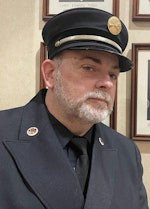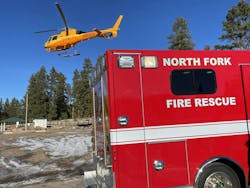In 2016, I came to the conclusion that I was burnt out with EMS. Or so I thought.
While I was in high school, I joined the volunteer fire department that my dad was a member of. I went to EMT right after graduation in 1986 while also attending college. I dropped out of college in 1988 to be an EMT “for the summer” in New York City and planned to go back to college that fall. That just-for-the-summer plan turned into paramedic school in 1989 and then a job with the Nassau County Police Department on Long Island in 1991. The job paid relatively well, life got in the way of school, and the job turned into a career. I spent 15 years on an ambulance between the city and the county, then spent the next 13 years as a supervisor.
I enjoyed being a paramedic. However, after several years, I found myself caught up in the bureaucracy of government-run healthcare, abuses of the 9-1-1 system, and just general feelings of stress and fatigue. Twenty-eight years of urban EMS took its toll on me mentally.
A few years prior, I bought a small home in rural Colorado that’s located about an hour from Denver. I took advantage of a generous retirement plan and left EMS. I recertified as a New York paramedic, but I had no plans to continue to operate as a medic.
Reinvigorated
A friend of mine from earlier in my career lived close by. He was the deputy chief of the local volunteer fire department, and he invited me to join. I figured, what the hell. I’m retired with not much else to do. I can drive fire trucks in the mountains.
So, in 2017, I joined the small, rural North Fork Volunteer Fire Department in Buffalo Creek, CO. The department had a career chief, 10–15 volunteers and three stations and covered about 240 square miles, the majority of which was in national forest land. The department was all-hazard, covering structure and wildland firefighting, backcountry rescue and swiftwater/ice rescue and supporting three ALS ambulances. The call volume was relatively low (150–200 runs per year); however, being so far from Denver meant that an average EMS run could be 3–4 hours instead of 45 minutes.
At first, I had to get wildland fire training. I also began to ride the ambulance, because they needed the help. I was encouraged to get a Colorado paramedic certification. Studying for the exams and catching up on all of the new advances in prehospital emergency medicine actually brought me out of my burnout funk. Our regional system and medical director also were much different than what I was used to in New York: very education-oriented and supportive of field personnel.
Time commitment
With my renewed sense of purpose as a paramedic, I transitioned to volunteer rural EMS. I learned that there are numerous operational differences between rural EMS and urban/suburban EMS.
First is the time commitment per call. The closest hospitals are 45–60 minutes away. When calls are in the national forest, it can be upward of two hours for a standard transport. Adding in the return trip and restocking, total time commitment can be as much as four hours. With limited personnel, we try to only send one ALS provider and a driver to the hospital.
Second, and likewise in conjunction with the long transport times, volunteers might need to decide among themselves who has the time for a transport. Members can’t rule out the possibility that they might miss work at their regular job if they go on a call before they are to report to their job and ride on the ambulance. A program that has paid-on-call part-time firefighters might help with this, because those members have an incentive to transport.
Another issue with the long transport times is managing patients for the extended ride. Fortunately, the Denver Metro protocols offer some additional capabilities for the paramedics to deal with the extended transport times. These include longer use of nitroglycerin in chest pain management and of IV fluids in regard to shock and sepsis and more monitoring documentation.
Also, after almost 30 years of never being more than 15 minutes from the hospital, I found out that I occasionally get motion sickness during long transports that often are on winding mountain roads. That said, I found that when I am actively working with a critical patient and am keeping busy, I usually am OK. On longer noncritical transports, I try to keep my gaze looking forward and to get air flow in the box.
Far-flung locations
Our district has more than 100 miles of mountain biking trails and two segments of the Colorado Trail. Often, patients are more than a mile from even a dirt road where we can get an ambulance. A standard backcountry rescue can require a couple of dozen rescuers. We don’t have that luxury. Even mutual aid from neighboring agencies can take an hour, and they are strapped for personnel as well. A volunteer search-and-rescue agency is available in our county, but they can take hours to respond, too.
With limited personnel, the department must come up with alternative methods of extracting patients.
One of the ways that we overcome these situations is with the use of two-wheel-drive motorcycles. We have two of these bikes made by Rokon. The low-speed/high-torque off-road motorcycles can navigate single-track trails more easily than ATVs or UTVs can.
We often deploy a paramedic on one of the motorcycles to locate a patient and provide initial care and size-up.
If the patient can ride, we often just get them out on the first motorcycle. If the patient requires stretcher evacuation, we deploy the second motorcycle with an attached Stokes stretcher that’s fitted to a narrow-tracked trailer. This operation often can be done with 2–4 people.
Because the motorcycles don’t go everywhere, standard single-wheel search-and-rescue Stokes stretchers are kept at the ready. Sometimes, a combination of both are used. If substantial staffing is really needed, a call can be made to a search-and-rescue team, which can send 20 or more people, but that often entails a 1–2-hour response.
We also utilize the services of several Denver-area air ambulance services, with helicopters landing in clearings in the forest, to cut down on transport times.
Recruitment
To combat declining membership and an increasing aging of the remaining members, the department recently employed several methods to beef up its system.
With a large area and small population, the department has had a difficult time—like everyone else across the country—attracting new volunteers, particularly in our case those who are young and strong enough for the work. In 2023, the department attempted to consolidate operations with two other districts in our county, hoping to pool resources and revenues to provide for some career personnel. That plan was turned down by voters in one of the other districts, which forced us to find an alternative solution.
Currently, we are in a pilot program by which some of our volunteers were hired on as paid-on-call, part-time employees, using funds from our reserves.
We also are trying to recruit new members for these positions. We hired a couple of people, but it will take time and training before they are ready.
Looking to the future, our board still is exploring consolidation options, as our rural tax base just can’t support a career staff on its own.

Tim Bono
M. Timothy Bono has been a paramedic since 1989 and in the fire service since 1985. He was a third-generation member of the Locust Valley, NY, Volunteer Fire Department from 1985–2012, where he was chief from 1999–2001. Bono started his EMS career with New York City Fire Department Bureau of EMS in 1988 and received his paramedic education with the agency in 1989. He also worked as a paramedic for the Nassau County, NY, Police Department for 25 years, retiring as a police medic coordinator in 2016. Bono currently is a member of the North Fork Volunteer Fire Department in Buffalo Creek, CO, where he serves as a volunteer firefighter/paramedic and part-time administrator. He teaches EMS skills at Red Rocks Community College in Lakewood, CO.







